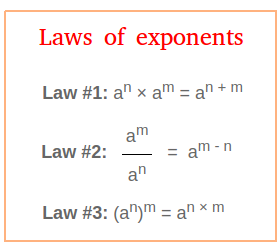Laws of Exponents
The laws of exponents help us to simplify terms containing exponents. We derive these laws here using some good examples.
A little reminder before we derive these laws of exponents:Recall that 2 × 2 × 2 = 23
We call 2 the base and 3 the exponent.
Let us now try to perform the following multiplication:
23 × 22
23 × 22 = (2 × 2 × 2) × (2 × 2) = 2 × 2 × 2 × 2 × 2 = 25
Notice that we can get the same answer by adding the exponents.
3 + 2 = 5
In the same way,
43 × 44 = (4 × 4 × 4) × (4 × 4 × 4 × 4)= 47
In general, add exponents to multiply numbers with the same base.
Law #1: an × am = an + m
If a stands for any number, a × a × a × a = a4
By the same token,
If a stands for any number, a × a × a × a × a × a × a = a7
a4 × a7 = a4 + 7 = a11
Let's do
58
55
We get
5 × 5 × 5 × 5 × 5 × 5 × 5 × 5
5 × 5 × 5 × 5 × 5
Rewrite the problem:
We get
5 × 5 × 5 × 5 × 5
5 × 5 × 5 × 5 × 5
× 5 × 5 × 5
Notice that
5 × 5 × 5 × 5 × 5
5 × 5 × 5 × 5 × 5
= 1
The reason for this is that whenever you divide something by the same thing, the answer is always 1.
The problem becomes 1 × 5 × 5 × 5 = 5 × 5 × 5 = 53
Notice that you can get the same answer if you do 8 - 5 = 3
Let's do also
715
79
We get
7 × 7 × 7 × 7 × 7 × 7 × 7 × 7 × 7 × 7 × 7 × 7 × 7 × 7 × 7
7 × 7 × 7 × 7 × 7 × 7 × 7 × 7 × 7
Rewrite the problem:
We get
7 × 7 × 7 × 7 × 7 × 7 × 7 × 7 × 7
7 × 7 × 7 × 7 × 7 × 7 × 7 × 7 × 7
× 7 × 7 × 7 × 7 × 7 × 7
Notice once again that
7 × 7 × 7 × 7 × 7 × 7 × 7 × 7 × 7
7 × 7 × 7 × 7 × 7 × 7 × 7 × 7 × 7
= 1
The reason for this is that whenever you divide something by the same thing, the answer is always 1.
The problem becomes 1 × 7 × 7 × 7 × 7 × 7 × 7 = 76
Notice that you can get the same answer if you do 15 - 9 = 6
In general, when dividing with exponents, you can just subtract the exponent of the denominator from the exponent of the numerator.
Law #2:
am
an
= am - n
What about
79
715
It is the same problem as before. However, this this time 9 is on top and 15 is at the bottom.
We can just use the formula
am
an
= am - n
79
715
= 79 - 15 = 7-6
Try now (83)4
An important observation:
In (83)4, the blue part is the base now and 4 is the exponent
Therefore, you can multiply 83 by itself 4 times.
83 × 83 × 83 × 83 = 83 + 3 + 3 + 3 = 812
Notice that you can get 12 by multiplying 3 and 4 since 3 × 4 = 12
Law #3: (an)m = an × m
All the laws of exponents are very useful, especially the last one.
The last makes it easy to simplify (65)200
Just multiply 5 and 200 to get 1000 and the answer is 61000
This figure summarizes the laws of exponents
